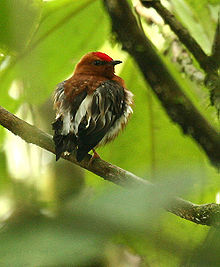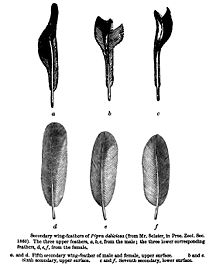- Club-winged Manakin
-
Club-winged Manakin 
Male in NW Ecuador Conservation status Scientific classification Kingdom: Animalia Phylum: Chordata Class: Aves Order: Passeriformes Family: Pipridae Genus: Machaeropterus Species: M. deliciosus Binomial name Machaeropterus deliciosus
(Sclater, 1852)The Club-winged Manakin (Machaeropterus deliciosus) is a small passerine bird which is a resident breeding species in the cloud forest on the western slopes of the Andes Mountains of Colombia and northwestern Ecuador. The manakins are a family (Pipridae) of small bird species of subtropical and tropical Central and South America.
Sound-making mechanism
Like several other manakins, the Club-winged Manakin produces a mechanical sound with its extremely modified secondary remiges.[3] The manakins have adapted their wings in this odd way as a result of sexual selection. Charles Darwin noted how females could cause evolutionary change simply by the influence of their mating preferences. Thus, in manakins, the males have evolved adaptations to suit the females' attraction towards sound. Wing sounds in many manakin lineages, however, have evolved independently. Some species pop like a firecracker, and there are a couple that makes whooshing noises in flight. The Club-winged Manakin, with its unique ability to produce musical sounds, is indisputably the most extreme example of sexual selection in manakins.
Each wing of the Club-winged Manakin has one feather with a series of at least seven ridges along its central vane. Next to the strangely ridged feather is another feather with a stiff, curved tip. When the bird raises its wings over its back, it shakes them back and forth over 100 times a second (hummingbirds typically flap their wings only 50 times a second). Each time it hits a ridge, the tip produced a sound. The tip strikes each ridge twice: once as the feathers collide, and once as they move apart again. This raking movement allows a wing to produce 14 sounds during each shake. By shaking its wings 100 times a second, the Club-winged Manakin can produce up to 1,400 single sounds during that time.
While this sort of spoon-and-washboard anatomy to produce sounds is well-known in insects - see stridulation -, it had not been well documented in vertebrates (some snakes stridulate too, but they do not have dedicated anatomical features for it). An analysis was made using high speed photography in 2005. The mating preferences of female birds can produce not only the peacock's tail or the rooster's crow, but also feathers with microscopic adaptations that let them sing like crickets.
References
- ^ Sclater, PL (1860). "List of Birds collected by Mr. Fraser in Ecuador, at Nanegal, Calacali, Perucho, and Puellaro, with notes and descriptions of new species". Proc. Zool. Soc. London: 83–97.
- ^ Darwin, Charles (1871). The descent of man and selection in relation to sex. volume 2. John Murray, London. pp. 65–66. http://www.archive.org/stream/descentofmansele02darw#page/65/mode/1up/.
- ^ Bostwick, Kimberly: From Feathers, a Violin. Cornell Lab of Ornithology (Includes photos of the feather structures)
External links
- BirdLife International (2004). Machaeropterus deliciosus. 2006. IUCN Red List of Threatened Species. IUCN 2006. www.iucnredlist.org. Retrieved on 12 May 2006. Database entry includes justification for why this species is of least concern
- ffrench, Richard; O'Neill, John Patton & Eckelberry, Don R. (1991): A guide to the birds of Trinidad and Tobago (2nd edition). Comstock Publishing, Ithaca, N.Y.. ISBN 0-8014-9792-2
- Hilty, Steven L. (2003): Birds of Venezuela. Christopher Helm, London. ISBN 0-7136-6418-5
- Stiles, F. Gary & Skutch, Alexander Frank (1989): A guide to the birds of Costa Rica. Comistock, Ithaca.
- New York Times
- Telegraph
- Bio One
- 2005-07-25 Cornell University News Service Rare South American bird 'sings' with its feathers to attract a mate, Cornell researcher finds
- Club-winged Manakin videos, photos & sounds on the Internet Bird Collection
- Bird "Sings" Through Feathers on National Geographic
Categories:- IUCN Red List least concern species
- Machaeropterus
Wikimedia Foundation. 2010.


